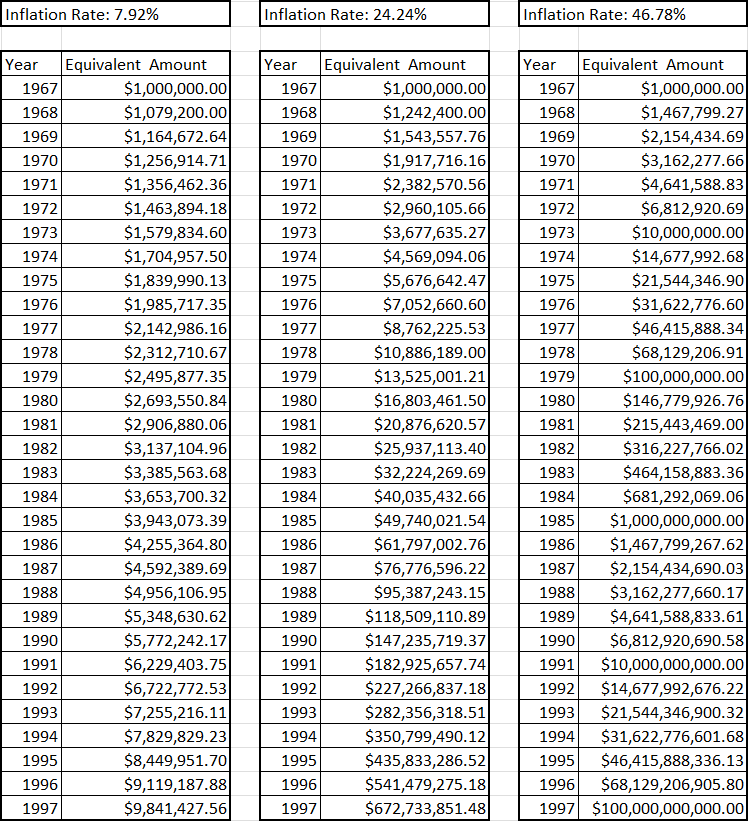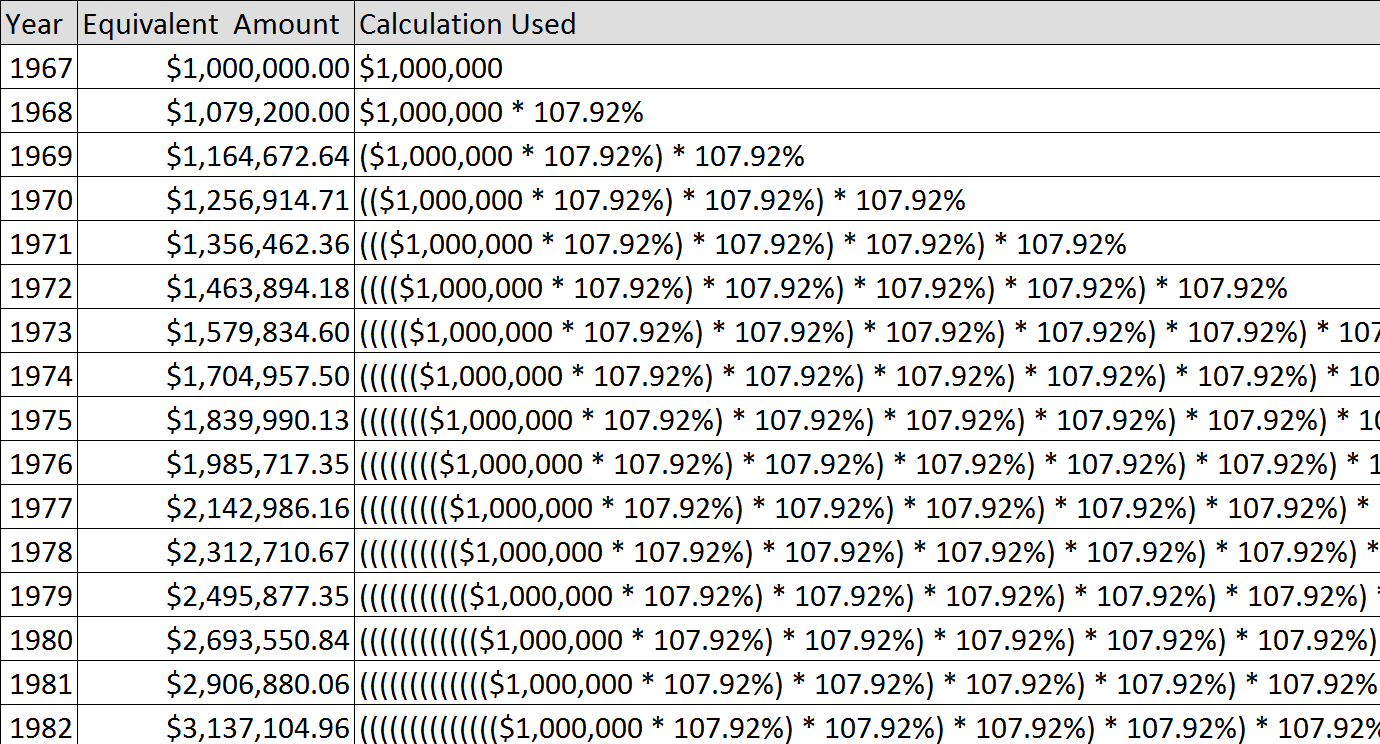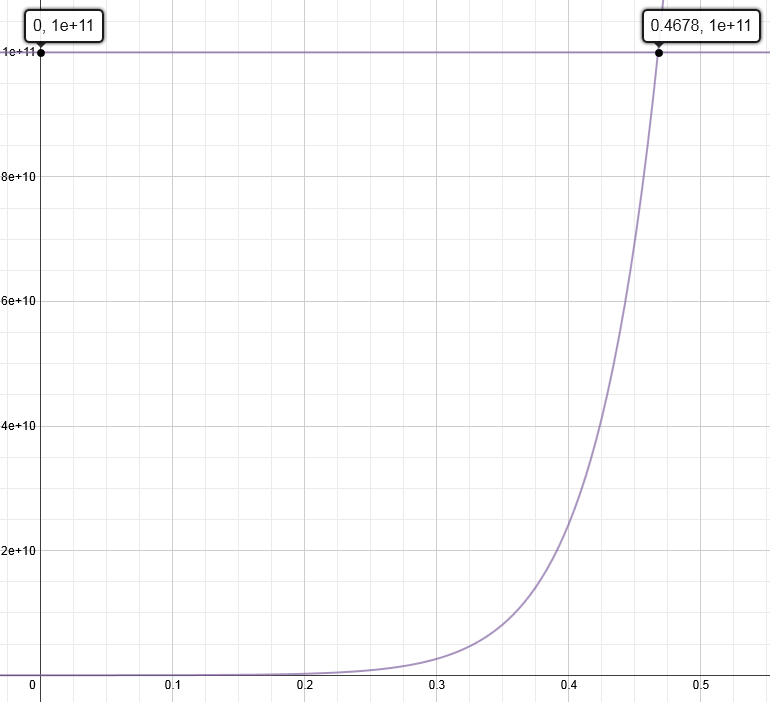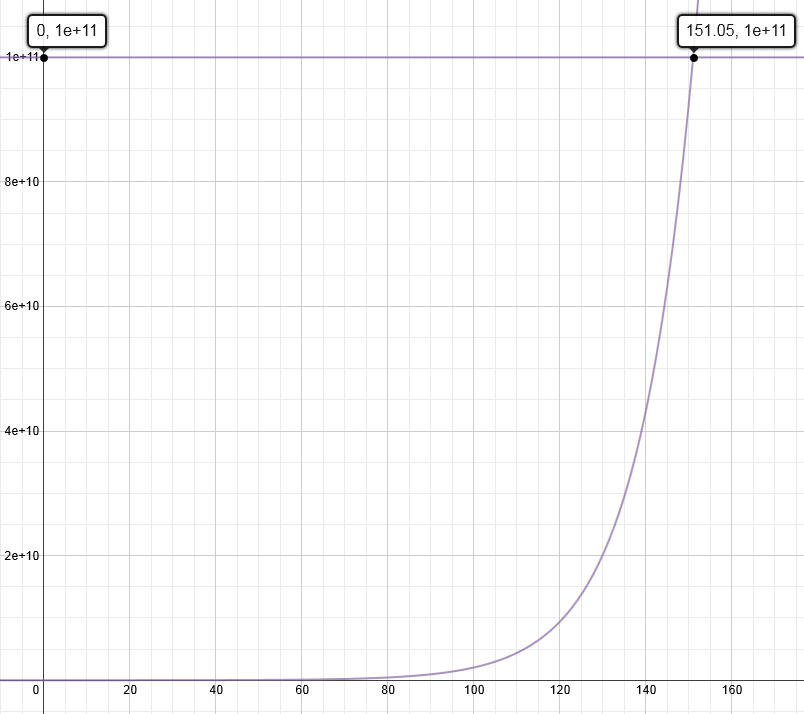- How much money should Dr. Evil demand?
- What would the inflation rate have to be for one million dollars in 1967 to be equivalent to one hundred billion dollars in 1997?
- When would demanding one hundred billion dollars be equivalent to demanding one million dollars in 1967?
- What is a guess that is too low?
- What is a guess that is too high?
- What is your best guess?
- Why did Dr. Evil originally demand $1,000,000?
- Why is Dr. Evil’s demand different than what you expected?
I imagine that after showing the video, students will already be asking themselves the first challenge question: “How much money should Dr. Evil demand?” To help them students think about which method they should use, I recommend beginning by asking students the following questions:
- What is a guess that is too low?
- What is a guess that is too high?
- What is your best guess?
It is also a good time to make sure students understand the movie’s context. Ask them, “Why did Dr. Evil originally demand $1,000,000?” and make sure they understand that he came from 1967 and it is now 1997. Students may reason about how much money Dr. Evil should demand using a few methods. Here are some thoughts I have:
- Hopefully students will realize that $1 million is a guess that is too low.
- They may think that it needs to be at least $9 billion since that is what Number 2 says their company makes in a year.
- They may also wonder about how much $1,000,000 in 1967 would be in 1997.
Eventually we want to get them to that third bullet and wonder about how to figure out how much money that would be. Eventually the conversation will turn to inflation being the cause for prices rising and students will want to know about how much inflation is.
The chart below shows the average annual inflation by decade for the United States and United Kingdom (where Dr. Evil lived). During the time period from 1967 (when Dr. Evil was cryogenically frozen) to 1997 (when he was unfrozen) inflation ranged from a low of 1.86% (US) and 1.59% (UK) to 13.52% US and 24.24% (UK). The inflation rates averaged 5.33% (US) and 7.92% (UK) during this time period. Obviously we are making assumptions here about which inflation rate best represents what Dr. Evil would have experienced and this is something worth discussing during class. For example, Dr. Evil and Austin Powers are from the United Kingdom but they are discussing money in United States dollars. I wasn’t sure which rate to use, so I have provided data for both countries.

Clearly the amount of money that would be equivalent to what $1 million was worth in 1967 will vary depending on what inflation rate students assume. The chart below lists 3 examples assuming students choose:
- 7.92% (average UK inflation for 1967-1997)
- 24.24% (highest UK inflation during 1967-1997)
- 46.78% (inflation rate needed for $100 billion to be the answer)

Rather than immediately jumping to procedural skill and fluency by giving students the compound interest formula, this is an opportunity to help students first build conceptual understanding from their knowledge of simple interest in 7th grade. For example, students may understand where compound interest is used (application) and know how to use the formula (procedural skill) but do they understand where the formula comes from and therefore how to derive it if they forget it? Consider having students create a chart similar to the one below (for a 7.92% inflation rate) to show the repeated calculations occurring with compound interest and work towards building the formula from there. The calculations show that the previous amount is being multiplied by 107.92% (100% for the original amount + 7.92% for the inflation rate). This will help them write “geometric sequences both recursively and with an explicit formula, use them to model situations, and translate between the two forms.” (CCSS F-BF.2)

When students have their guesses as to what Dr. Evil should ask for (including guesses based on inflation), play the clip below:
Once students have heard the clip and have discussed how their answers compare, ask them the next challenge question: “What would the inflation rate have to be for one million dollars in 1967 to be equivalent to one hundred billion dollars in 1997?” Students will have to set up and solve the following equation:
100,000,000,000 = 1,000,000 * x^30
Be sure to ask students what each part of the equation means:
- The 100 billion represents the amount we want an equivalent value to
- The 1 million represents the amount we are beginning with
- The x represents the unknown inflation rate
- The 30 represents the number of years we are compounding for.
Solving for x, the inflation rate needed for $1 million in 1967 to have the equivalent buying power as $100 billion in 1997 is ~46.78%. Below is a visual representation of the answer using the Desmos online graphing calculator:

The next challenge question offers up a slightly different task: “When would demanding one hundred billion dollars be equivalent to demanding one million dollars in 1967?” Instead of having a fixed amount of time (30 years) and figuring out what the inflation rate would have to be, now they have a fixed inflation rate and have to figure out how many years it would take. I assumed a 7.92% inflation rate but students could pick any inflation rate they want. It would be great to have a conversation with students who started with one inflation rate and then realized that they should change to a higher inflation rate to speed up the process. Students will have to set up and solve an equation similar to the one below:
100,000,000,000 = 1,000,000 * (1 + 0.0792)^x
Be sure to ask students what each part of the equation means:
- The 100 billion represents the amount we want an equivalent value to
- The 1 million represents the amount we are beginning with
- In the (1 + 0.792), the 1 represents 100% for the original amount and the 0.0792 represents the 7.92% inflation rate (which could be substituted with any other inflation rate students want to use).
- The x represents the number of years we are compounding for.
Solving for x and assuming a 7.92% inflation rate, the number of years needed for $1 million in 1967 to have the equivalent buying power as $100 billion is ~151 years. The significance of 151 years is that Dr. Evil jumped to such a large amount of money that it would take 151 years from 1967 (the year 2118) for $1 million to have the equivalent value to $100 billion. Below is a visual representation of the answer using Desmos online graphing calculator:

Look at standards to make sure each one is actually included (F-IF.8b and F-LE.4 for example)
- CCSS N-RN.2 Rewrite expressions involving radicals and rational exponents using the properties of exponents.
- CCSS A-SSE.1 Interpret expressions that represent a quantity in terms of its context.★
- CCSS A-SSE.3c Use the properties of exponents to transform expressions for exponential functions. For example the expression 1.15t can be rewritten as (1.151/12)12t ≈ 1.01212t to reveal the approximate equivalent monthly interest rate if the annual rate is 15%.
- CCSS A-SSE.4 Derive the formula for the sum of a finite geometric series (when the common ratio is not 1), and use the formula to solve problems. For example, calculate mortgage payments.★
- CCSS A-REI.11 Explain why the x-coordinates of the points where the graphs of the equations y = f(x) and y = g(x) intersect are the solutions of the equation f(x) = g(x); find the solutions approximately, e.g., using technology to graph the functions, make tables of values, or find successive approximations. Include cases where f(x) and/or g(x) are linear, polynomial, rational, absolute value, exponential, and logarithmic functions.★
- CCSS F-IF.4 For a function that models a relationship between two quantities, interpret key features of graphs and tables in terms of the quantities, and sketch graphs showing key features given a verbal description of the relationship. Key features include: intercepts; intervals where the function is increasing, decreasing, positive, or negative; relative maximums and minimums; symmetries; end behavior; and periodicity.★
- CCSS F-IF.7e Graph exponential and logarithmic functions, showing intercepts and end behavior, and trigonometric functions, showing period, midline, and amplitude.
- CCSS F-IF.8b Use the properties of exponents to interpret expressions for exponential functions. For example, identify percent rate of change in functions such as y = (1.02)t, y = (0.97)t, y = (1.01)12t, y = (1.2)t/10, and classify them as representing exponential growth or decay.
- CCSS F-BF.2 Write arithmetic and geometric sequences both recursively and with an explicit formula, use them to model situations, and translate between the two forms.★
- CCSS F-LE.1c Recognize situations in which a quantity grows or decays by a constant percent rate per unit interval relative to another.
- CCSS F-LE.4 For exponential models, express as a logarithm the solution to abct = d where a, c, and d are numbers and the base b is 2, 10, or e; evaluate the logarithm using technology.
- CCSS F-LE.5 Interpret the parameters in a linear or exponential function in terms of a context.



3 Comments